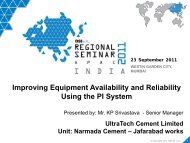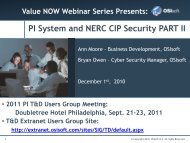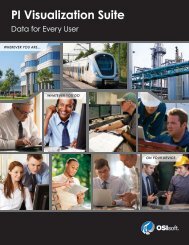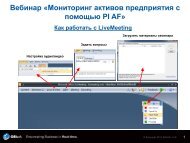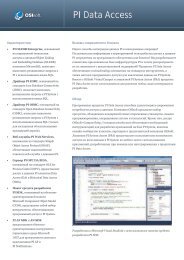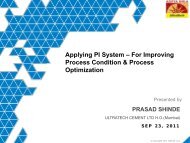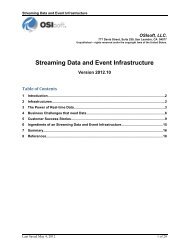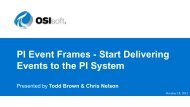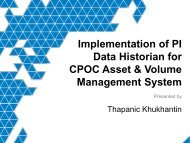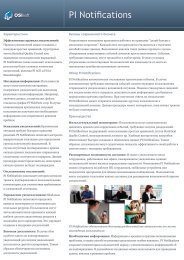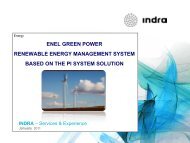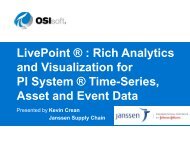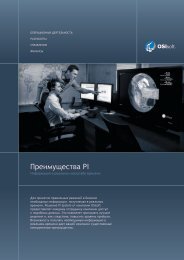OSIsoft PI High Availability (HA) & Virtualization
OSIsoft PI High Availability (HA) & Virtualization
OSIsoft PI High Availability (HA) & Virtualization
Create successful ePaper yourself
Turn your PDF publications into a flip-book with our unique Google optimized e-Paper software.
<strong>OSIsoft</strong> <strong>PI</strong> <strong>High</strong> <strong>Availability</strong> (<strong>HA</strong>)<br />
& <strong>Virtualization</strong><br />
Complementary & contrasting technical approaches to <strong>HA</strong><br />
Guy F. Acciai<br />
Integrated Manufacturing System Architect<br />
Corning Incorporated - Blacksburg, VA<br />
© Copyright 2010, Corning Incorporated. All rights reserved.
Agenda<br />
• Who is Corning and what do we do…<br />
• Corning Life Science (CLS) manufacturing<br />
– The need for a historian, a MES, and <strong>High</strong> <strong>Availability</strong> (<strong>HA</strong>)<br />
• <strong>HA</strong> & <strong>Virtualization</strong><br />
– <strong>PI</strong> and VMware product offerings – Pros/Cons & Tradeoffs<br />
• CLS - Final Architecture<br />
– Usage of complementary tools & “watch-outs”<br />
• Usage to date<br />
• Futures Needs & Questions<br />
– <strong>PI</strong> Wants<br />
– VMWare Wants<br />
© Copyright 2010, Corning Incorporated. All rights reserved.
Founded:<br />
1851<br />
Headquarters:<br />
Corning, New York<br />
Employees:<br />
≈23,500 worldwide<br />
2009 Revenues:<br />
$5.4 Billion<br />
Fortune 500 Rank:<br />
391<br />
Corning Incorporated<br />
• Corning is the world leader in<br />
specialty glass and ceramics.<br />
• We create and make keystone<br />
components that enable hightechnology<br />
systems for consumer<br />
electronics, mobile emissions<br />
control, telecommunications and<br />
life sciences.<br />
• We succeed through sustained<br />
investment in R&D, over 150 years<br />
of materials science and process<br />
engineering knowledge, and a<br />
distinctive collaborative culture.<br />
© Copyright 2010, Corning Incorporated. All rights reserved.
Glass envelope for<br />
Thomas Edison’s<br />
light bulb<br />
1879<br />
Corning’s Culture of Innovation<br />
1915<br />
Heat-resistant<br />
Pyrex ® glass<br />
Dow Corning<br />
silicones<br />
1934<br />
1947<br />
Processes for mass<br />
producing the<br />
television bulb<br />
Glass ceramics<br />
Ceramic substrates<br />
for automotive<br />
catalytic converters<br />
1952 1960<br />
1970 1972 1984 2006<br />
Fusion draw<br />
process<br />
First low-loss<br />
optical fiber<br />
© Copyright 2010, Corning Incorporated. All rights reserved.<br />
<strong>High</strong>-throughput<br />
label-free screening<br />
platform for<br />
drug discovery<br />
AMLCD glass for<br />
TVs, notebook<br />
computers &<br />
monitors
Display<br />
Technology<br />
• LCD Glass<br />
Substrates<br />
• Glass Substrates<br />
for OLED and<br />
LTPS-LCD<br />
Market Segments & Operations<br />
Telecom<br />
• Optical Fiber &<br />
Cable<br />
• Hardware &<br />
Equipment<br />
− Fiber optic<br />
connectivity<br />
products<br />
− Optical<br />
connectivity<br />
products<br />
Environmental<br />
Technologies<br />
• Emissions Control<br />
Products<br />
– Light-duty<br />
gasoline<br />
vehicles<br />
– Light-duty and<br />
heavy-duty<br />
diesel vehicles<br />
– Stationary<br />
Life<br />
Sciences<br />
• Cell Culture &<br />
Bioprocess<br />
• Assay & <strong>High</strong>-<br />
Throughput<br />
Screening<br />
• Genomics &<br />
Proteomics<br />
• General<br />
Laboratory<br />
Products<br />
Specialty<br />
Materials<br />
• Display Optics &<br />
Components<br />
• Semiconductor<br />
Optics/Components<br />
• Aerospace/Defense<br />
• Astronomy<br />
• Optical Metrology<br />
• Ophthalmic<br />
• Telecom<br />
Components<br />
• Specialty Glass<br />
© Copyright 2010, Corning Incorporated. All rights reserved.<br />
Other<br />
Products<br />
& Services<br />
• Display Futures<br />
• New Business<br />
Development<br />
• Drug Discovery<br />
Technology<br />
• Equity Companies<br />
– Cormetech, Inc.<br />
– Dow Corning Corp.<br />
– Eurokera, S.N.C.<br />
– Samsung Corning<br />
Corning Life Sciences (CLS)<br />
Developer, manufacturer and global supplier of innovative life science product<br />
solutions for over 90 years
CLS Manufacturing<br />
• Over time, products have shifted from borosilicate<br />
glass to greater use of sterile/disposable plastic<br />
• Extensive use of injection molding to form plastic<br />
parts used for medical testing and drug discovery<br />
• FDA regulation and traceability requirements<br />
• Focus on overall equipment & labor effectiveness<br />
(OEE) as well as scrap & downtime pareto analysis<br />
• Business decision to deploy a Manufacturing<br />
Execution System (MES)<br />
© Copyright 2010, Corning Incorporated. All rights reserved.
Business need for <strong>HA</strong><br />
• Use of existing <strong>PI</strong> server as SCADA (and historian) to act<br />
as IO interface to MES<br />
• MES generates product labeling & interacts with<br />
inventory systems – availability is paramount<br />
© Copyright 2010, Corning Incorporated. All rights reserved.
<strong>High</strong> <strong>Availability</strong><br />
• Definition: a system design & associated implementation<br />
that ensures a certain degree of operational continuity<br />
during a given time period<br />
– Design for availability given planned & unplanned downtime<br />
• Major approach is replication & redundancy<br />
• Historical Approaches:<br />
– Clusters & load balancing<br />
– Redundant/Failover Hardware (ie, Tandem, Status, RAID)<br />
– Marathon EverRun<br />
– Stratus ftServers (with ActiveUpgrade or Avance SW)<br />
• <strong>OSIsoft</strong> History<br />
– <strong>OSIsoft</strong> <strong>PI</strong> server on a MSCS<br />
– Interface Redundancy<br />
– <strong>PI</strong> Server - <strong>HA</strong><br />
© Copyright 2010, Corning Incorporated. All rights reserved.
<strong>PI</strong> Interface Failover<br />
• Been available in some interfaces for several years<br />
• OPC is “model interface” - Need to “license two OPC”<br />
interfaces, or rule of 3 interfaces<br />
• Supports two “types” of <strong>HA</strong><br />
– Support for “redundant” OPC servers<br />
– Support for “redundant” <strong>PI</strong> OPC interfaces<br />
• UnInit based (preferred) or MS cluster based<br />
• Our implementation, uses redundant OPC servers on<br />
redundant interface nodes<br />
© Copyright 2010, Corning Incorporated. All rights reserved.
<strong>PI</strong> Interface Failover Architecture<br />
<strong>PI</strong> SDK, <strong>PI</strong> A<strong>PI</strong><br />
Interface Buffer<br />
<strong>PI</strong> SDK, <strong>PI</strong> A<strong>PI</strong><br />
Interface Buffer<br />
<strong>PI</strong> SDK, <strong>PI</strong> A<strong>PI</strong><br />
Interface Buffer<br />
<strong>PI</strong> SDK, <strong>PI</strong> A<strong>PI</strong><br />
Interface Buffer<br />
• OPC server coordination support for 3 different modes:<br />
– Hot Mode, Warm, Cold<br />
• Redundant OPC Interface Coordination<br />
– 8 specific “control” tags - to avoid the “Split-Brain” problem<br />
– Phase I (on OPC source) and Phase II (shared file)<br />
© Copyright 2010, Corning Incorporated. All rights reserved.<br />
<strong>PI</strong> SDK, <strong>PI</strong> A<strong>PI</strong><br />
Interface Buffer
Interface 1<br />
Heartbeat<br />
Interface 2<br />
BufSS<br />
BufSS<br />
CLS <strong>HA</strong> Topology<br />
<strong>PI</strong> Server 1<br />
Configuration Data<br />
<strong>PI</strong> Server 2<br />
<strong>PI</strong> Collective<br />
User Workstation<br />
connects to any<br />
available data<br />
source<br />
© Copyright 2010, Corning Incorporated. All rights reserved.<br />
`
Collective Naming & Migration<br />
• For “migration” of a new “collective” to replace an existing <strong>PI</strong><br />
server – Must name collective with same name as old server<br />
– Collective is virtual<br />
• Has no IP address & only “visible” to <strong>PI</strong> SDK/A<strong>PI</strong><br />
– Need to match/force “<strong>PI</strong> Server ID”<br />
• Some SDK/A<strong>PI</strong>’s tools use ServerID, and others Server Name<br />
• Tools are good, and migration is not hard<br />
– But fairly complex topic, and requires understanding and planning<br />
– Migration also involved network team to control “timing” around DNS<br />
switch to point old server name to new collective<br />
– Upgrade Approach<br />
• Interfaces first, to support buffer to “old server” & collective for testing<br />
• Collective Formation (Keep old server for fallback)<br />
• Client Upgrade<br />
• Shutdown old server<br />
© Copyright 2010, Corning Incorporated. All rights reserved.
<strong>PI</strong> <strong>HA</strong> - Pros and Cons<br />
• Pros - Improved:<br />
– Reliability (semi-transparent failover)<br />
– DR support (Multiple Servers in diverse locations)<br />
– Application availability during maintenance (rolling upgrades &<br />
security patching)<br />
• Cons - <strong>High</strong>er Costs & Complexity<br />
– SW <strong>OSIsoft</strong> - (Additional <strong>PI</strong> Server and interfaces)<br />
• Enterprise License can mitigates this<br />
– HW – Duplicate HW (Servers AND Storage)<br />
• <strong>Virtualization</strong> helps mitigate some of these costs<br />
– Greater complexity (Greenfield easy, Migration more complex)<br />
– Various interfaces don’t support UniInt failover (yet)<br />
– Various limitations around <strong>HA</strong> V1<br />
© Copyright 2010, Corning Incorporated. All rights reserved.
Current <strong>PI</strong> <strong>HA</strong> Limitations:<br />
• Changes to tags/metadata can ONLY happen on primary<br />
• Archive annotations and changes to annotations are not<br />
currently propagated to the collective.<br />
• Non-Interface data (Manual writes/Lab Points) are<br />
not currently propagated to the collective<br />
• <strong>PI</strong>Bagen will not generate the same batch-ids for<br />
batches generated on different servers. <strong>PI</strong>Bagen and<br />
“old” batch data is not replicated between servers in the<br />
collective<br />
• Acknowledgement of alarms is not currently replicated<br />
between servers in the collective.<br />
• Many of these are to be addressed in PR2 of <strong>HA</strong><br />
© Copyright 2010, Corning Incorporated. All rights reserved.
<strong>Virtualization</strong><br />
• Definition: <strong>Virtualization</strong> is abstraction performed on a<br />
given hardware platform by host software (a control<br />
program), which creates a simulated computer<br />
environment, a “virtual machine”, for guest software.<br />
• Alternatives – In the Server Space (on Windows)<br />
– MS Hyper-V (and MS Virtual Server)<br />
– VMWare ESX Cluster + VMotion (and VM Server)<br />
• Problems its solves<br />
– Server consolidation - reduced energy and physical footprint<br />
– Improved availability & operational flexibility (provisioning)<br />
– Disaster recovery<br />
© Copyright 2010, Corning Incorporated. All rights reserved.
Corning’s drive to virtualization<br />
• Large multi-year effort by central IT groups to setup<br />
failover ESX clusters in each site to support “standard” IT<br />
functions (4 servers):<br />
– IT Core Services (File & Print/Backup/Patching/AV/DC/DNS/DHCP/etc.)<br />
• General approach is to “virtualize everything we can”<br />
• Attempt to “leverage” this standardized investment for<br />
manufacturing and site specific applications<br />
– <strong>PI</strong> is a “well behaved” application, with predictable resource<br />
demands, that is easily virtualized<br />
© Copyright 2010, Corning Incorporated. All rights reserved.
<strong>OSIsoft</strong> formally supports VMs<br />
• ArticleID: 3062OSI8 - A <strong>PI</strong> Server is supported<br />
when installed on a virtual machine that’s<br />
running a supported operating system.<br />
– With the caution: Considerations must be made to<br />
evaluate how much resource contention is expected<br />
at peak loads. Critical resources are usually I/O<br />
bandwidth and disk resources<br />
• Corning has several <strong>PI</strong> servers running on<br />
VMware – Actually painless to virtualize, given<br />
sufficient resources (generally scales linearly with tag count)<br />
© Copyright 2010, Corning Incorporated. All rights reserved.
VMWare Architecture<br />
• ESX physical clusters<br />
– <strong>HA</strong> – Auto-Restart (on OS or<br />
HW failure – Not Application)<br />
– DRS – Load Balancing<br />
– Implies S<strong>HA</strong>RED Storage<br />
• Key component to<br />
Corning’s <strong>HA</strong><br />
environment is VMotion<br />
– Move running virtual<br />
machines from one physical<br />
server to another with NO<br />
impact to end users<br />
© Copyright 2010, Corning Incorporated. All rights reserved.
VMWare - Pros and Cons<br />
• Pros - Improved:<br />
– Reliability (automatic restart on “crash”)<br />
– Scalability & QOS (Easy “add” of additional resources to guests<br />
& “hot” additional of nodes to ESX cluster, DRS load balancing)<br />
– DR support (VMware Snapshots & Distributed Clusters)<br />
– <strong>Availability</strong> during planned HW maintenance (Vmotion)<br />
– Better utilization of HW, energy & floor space savings<br />
• Cons - <strong>High</strong>er Costs<br />
– SW VMWare ESX & VMotion<br />
• Enterprise license helps here<br />
– Greater complexity (Affinity Rules, VIC Access, etc)<br />
– Requires better coordination and control around shared physical<br />
resources<br />
– Lack of support for “esoteric” HW interfaces<br />
© Copyright 2010, Corning Incorporated. All rights reserved.
Comparisons & Contrasts<br />
• <strong>PI</strong>: Basic approach is redundancy<br />
– Multiple instances of <strong>PI</strong> (server and/or interface running) but “bound”<br />
to HW<br />
• VM: Separation from physical HW<br />
– Single instance of application – But “divorced” from physical HW<br />
• Our Approach – Use both, to get more “flexibility”<br />
around physical resources, and redundancy of<br />
multiple instances of <strong>PI</strong><br />
• Tradeoffs: Cost and Complexity<br />
© Copyright 2010, Corning Incorporated. All rights reserved.
Final Architecture – CLS design<br />
• 3 Physical Servers (all in<br />
ESX cluster)<br />
• 18 “Guests”<br />
– 4 IT Servers<br />
– 3 Development Servers<br />
– 4 <strong>PI</strong> servers<br />
– 6 MES servers<br />
– 1 Other<br />
• Designed to support<br />
shutdown of 1 physical<br />
server with no impact<br />
• Rules to “keep” failover<br />
pairs on separate physical<br />
servers<br />
© Copyright 2010, Corning Incorporated. All rights reserved.
Final Architecture - Watchouts<br />
• Need to define VMWare affinity rules - To keep redundant <strong>PI</strong> nodes<br />
on separate physical hardware in ESX cluster<br />
• We also use MS NLB (on other servers) for higher level MES<br />
failover setup – Significant setup complexity with server and network<br />
teams around physical and virtual VLAN configurations<br />
© Copyright 2010, Corning Incorporated. All rights reserved.
Usage to date & Results<br />
• Been operational for about 1.5 years<br />
– One unplanned <strong>PI</strong> interface outage (about 20 mins) due to failure<br />
around misconfiguration of shared interface file<br />
• VMWare and VMotion<br />
– Added third physical node to ESX cluster for scalability “while hot”<br />
– Numerous virtual server moves (“VMigrations”) for load balancing<br />
– VMigration to move active <strong>PI</strong> servers off HW replace failing SCSI card<br />
used for backup tape server<br />
– Have had NO downtime associated with VMWare or VMotion<br />
• <strong>PI</strong> <strong>HA</strong><br />
– Migrated interface nodes from XP to virtual Win03 servers while “hot”<br />
– Support for numerous server and interface node reboots for applying<br />
monthly windows security patches & OPC interface upgrades<br />
– “Unplanned” power outage corrupted <strong>PI</strong> databases on <strong>PI</strong> <strong>HA</strong> Primary –<br />
Was able to “promote” secondary to primary, and re-initialize “old”<br />
primary – No data lose or customer outage<br />
© Copyright 2010, Corning Incorporated. All rights reserved.
Future / Next Steps<br />
• Future needs for <strong>OSIsoft</strong> toolsets<br />
– Continue to make more interfaces support failover<br />
– N-way fanout of data from custom application writes<br />
via SDK rather than just A<strong>PI</strong><br />
– Server-to-server replication – Need to address limits<br />
of <strong>HA</strong> V1<br />
• VMWare<br />
– VSphere – V4 – Fault Tolerance Feature<br />
• Sets up redundant VM’s and keeps in lockstep<br />
© Copyright 2010, Corning Incorporated. All rights reserved.
Thank you



